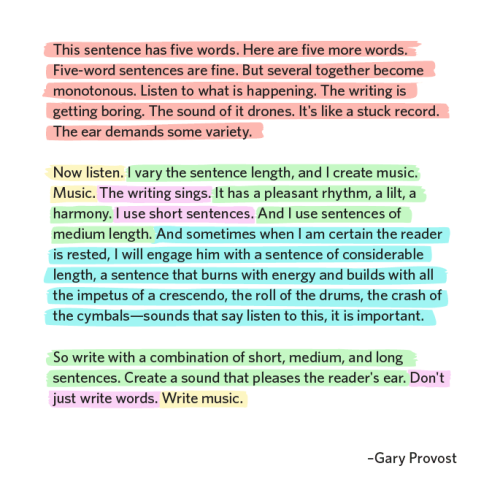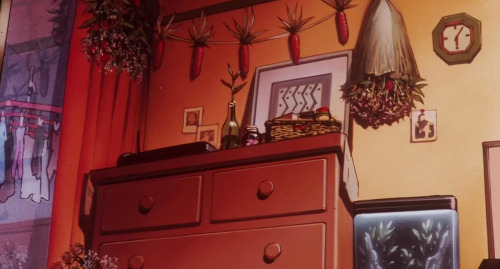A Very Useful Demonstration Of The Importance Of Sentence Length.

A very useful demonstration of the importance of sentence length.
More Posts from Theidlerhour and Others
in your opinion, what's going to happen when the physical properties of silicon can't sustain moore's law anymore
nothing, for two reasons
first some background: moore’s law states that every year the number of components (transistors) on integrated circuits will double (due to engineering breakthroughs). it has proved to be somewhat correct. it occurs due to our ability to manufacture smaller and smaller transistors which has a few effects, discussed later. eventually we will hit a point where it no longer matters how small we can print transistors as the fundamental electrical characteristics of silicon break down
in the next couple of years, we will see chips from intel with transistors printed about ten nanometers apart. we approach the limits silicon can handle, theoretically, around ~1nm
in circuits this small, you start seeing tunneling effects which are phenomenons of quantum physics wherein the propagation delay of charge falls to zero, meaning stimulation of the source terminal of a transistor would elicit a response on the drain terminal without any time elapsing. electrons just “blink” from one end of the xsistor to the other. you’d think this would be a good thing, but it isn’t. anyone with advanced physics degrees or deep VLSI knowlege is welcome to chime in why.
anyway
the first reason is there is no alternative to silicon. we have poured billions into researching things like gallium arsenide as a replacement for silicon in integrated circuits. it doesn’t work as well as silicon. people will try to convince you otherwise and those people are crackpots
we have poured a lot of time & money into researching quantum computers and discovered that they are only superior for very specific tasks such as brute-forcing encryption keys and other things of that nature. they will also probably never cost a billion dollars each to manufacture, never need anything less than a power plant and vats of liquid helium to operate, etc etc
the logical “next step” might be optical computing. here, you fundamentally change the hardware paradigm from electrons traveling through traces cut in a mediating silicon substrate between transistors to photons traveling through ?? mediated by ?? between “phototransistors”. the underlying principle is that light, in some cases, travels faster than voltage propagates through conductors. i’m going to get a lot of asks saying “durr kremlin but the speed of light is constant and i took high school physics and blah blah blah” and that’s a discussion worth its own post
this kind of tech is far off. not in our lifetime, not in your children’s lifetime, not in your children’s children’s lifetime
the reason we make transistors smaller is so we can pack them together more closely. this reduces the distance charge must travel in the circuit, making the cycles of these circuits take less time to complete. smaller transistors also generally necessitate less impedance and operate correctly at lower voltages, meaning their operating frequency can increase without a corresponding drop in reliability
these are all nice things, but they are only one piece of the puzzle. how you lay out these transistors is a much more critical and relevant problem. taking a previous VLSI design and shrinking it only works to a point after which you must redesign the layout entirely. intel’s “tick-tock” release/development department follows this model. long before and long after we hit the fundamental limits of silicon, the problem will be laying out our CPU circuits in such a way that we can actually eek out the performance provided by smaller transistors. this is a much, much harder problem to solve than “how do i make the transistor smaller”
the second, more pragmatic reason is that CPUs are fast enough already. there are scarce few problems that can be solved with faster discrete processors that can’t be solved with a million slower ones linked together
the whole tiny-transistor thing is really more of a marketing phenomenon than anything else




I honestly don't mean for this to come across as ignorant or anything like that but I just seen your post about learning kanji's and they're Chinese characters? I didn't know Japanese used Chinese characters? I've only started learning mandarin but I never knew that Japanese used the same characters?
It’s not ignorant at all, please don’t feel that way! Years and years ago in Japan there was no comprehension of such characters, but some Japanese people were sent to China as scholars to basically learn everything about Classical Chinese and due to this there was a sudden (but still rather small) increase in Chinese literacy. It still took a while for Kanji to be fully incorporated into the Japanese language, and even the two other alphabets (hiragana and katakana) are said to be based off of the way in which Chinese was written during this time, in attempt to break down the language barriers between the two nations. Until these alphabets were used the Japanese didn’t have a writing system at all! This means that immigration and visitors from China and Korea in particular have had an influence on the way in which the Japanese language has evolved, and this is most likely why there are some similarities between Japanese and other languages you may study. Chinese and Japanese characters still have particular differences, so somebody who speaks Japanese/Chinese may briefly understand a text based on characters from their original tongue, but in general the strokes are sometimes varied and the pronunciation is completely different so they wouldn’t be able to read it fluently like one might expect (even if the character looks nearly identical.) Sorry if any of my information is wrong- this is just some general knowledge that I’ve picked up from my own research and studies!

If you keep dividing the line segment infinitely you get something really interesting. It is called Cantor Dust. You get an infinite number of points with a total length of zero’ Fathom the Universe
Fabiola Gianotti

Particle physicist Fabiola Gianotti was born on October 29, 1960 in Rome, Italy. In 2014, it was announced that she will become CERN’s next Director-General beginning in 2016. As head of Atlas, one of CERN’s principle detector projects that discovered the Higgs-Boson particle, she oversaw a team of 3,000 scientists. She also serves on the Scientific Advisory Board of the UN Secretary General.
Happy birthday, Fabiola Gianotti!
photo: fabiola gianotti/origin symposium, claudia marcelloni
photo license

friend: I don't particularly like Sappho's poetry--
me: But you will lie dead, nor will there be any memory of you, now or in the future, for you will have no share in the Pierian roses, but invisible, in the house of Hades, you will wander to and fro, fluttering with the shadowy ghosts,
Goals:
1. Do science. 2. Advance the human race. 3. Make other people happy.
-
 greenduck54 liked this · 1 month ago
greenduck54 liked this · 1 month ago -
 suprsingr reblogged this · 2 months ago
suprsingr reblogged this · 2 months ago -
 lunatic-callisto liked this · 3 months ago
lunatic-callisto liked this · 3 months ago -
 xx-leech liked this · 3 months ago
xx-leech liked this · 3 months ago -
 lover-of-lamp liked this · 3 months ago
lover-of-lamp liked this · 3 months ago -
 faiakishi reblogged this · 3 months ago
faiakishi reblogged this · 3 months ago -
 faiakishi liked this · 3 months ago
faiakishi liked this · 3 months ago -
 mercurymiscellany reblogged this · 3 months ago
mercurymiscellany reblogged this · 3 months ago -
 gobbounchained19 liked this · 4 months ago
gobbounchained19 liked this · 4 months ago -
 cafeselection reblogged this · 4 months ago
cafeselection reblogged this · 4 months ago -
 autisticchangeling77 liked this · 4 months ago
autisticchangeling77 liked this · 4 months ago -
 megazaprat reblogged this · 6 months ago
megazaprat reblogged this · 6 months ago -
 tactical-errors reblogged this · 8 months ago
tactical-errors reblogged this · 8 months ago -
 tactical-errors liked this · 8 months ago
tactical-errors liked this · 8 months ago -
 iamnotyourgodsherald reblogged this · 8 months ago
iamnotyourgodsherald reblogged this · 8 months ago -
 iamnotyourgodsherald liked this · 8 months ago
iamnotyourgodsherald liked this · 8 months ago -
 tutorial-pile reblogged this · 8 months ago
tutorial-pile reblogged this · 8 months ago -
 101justcurious liked this · 8 months ago
101justcurious liked this · 8 months ago -
 echo146 liked this · 10 months ago
echo146 liked this · 10 months ago -
 zipzapwoohoo liked this · 10 months ago
zipzapwoohoo liked this · 10 months ago -
 lazulili liked this · 1 year ago
lazulili liked this · 1 year ago -
 candlecakes liked this · 1 year ago
candlecakes liked this · 1 year ago -
 sassygaykuja reblogged this · 1 year ago
sassygaykuja reblogged this · 1 year ago -
 csr-writings liked this · 1 year ago
csr-writings liked this · 1 year ago -
 halfdim liked this · 1 year ago
halfdim liked this · 1 year ago -
 natarisaru liked this · 1 year ago
natarisaru liked this · 1 year ago -
 saradots-scribbles liked this · 1 year ago
saradots-scribbles liked this · 1 year ago -
 sunnycowleaf liked this · 1 year ago
sunnycowleaf liked this · 1 year ago -
 darlingjiji reblogged this · 1 year ago
darlingjiji reblogged this · 1 year ago -
 katanra liked this · 1 year ago
katanra liked this · 1 year ago -
 attack-on-yuri liked this · 1 year ago
attack-on-yuri liked this · 1 year ago -
 bonicle liked this · 1 year ago
bonicle liked this · 1 year ago -
 therabbitthatpostthings reblogged this · 1 year ago
therabbitthatpostthings reblogged this · 1 year ago -
 therabbitthatpostthings liked this · 1 year ago
therabbitthatpostthings liked this · 1 year ago -
 catsforthecatgod liked this · 1 year ago
catsforthecatgod liked this · 1 year ago -
 lenadamnvers reblogged this · 1 year ago
lenadamnvers reblogged this · 1 year ago -
 lenadamnvers liked this · 1 year ago
lenadamnvers liked this · 1 year ago -
 askprofessorx liked this · 1 year ago
askprofessorx liked this · 1 year ago -
 simplymyae-blog liked this · 1 year ago
simplymyae-blog liked this · 1 year ago -
 chamomillepeachtea liked this · 1 year ago
chamomillepeachtea liked this · 1 year ago -
 bookcluberror reblogged this · 1 year ago
bookcluberror reblogged this · 1 year ago -
 biezifarphoga liked this · 1 year ago
biezifarphoga liked this · 1 year ago -
 hauntingbecke reblogged this · 1 year ago
hauntingbecke reblogged this · 1 year ago -
 hauntthebodies liked this · 1 year ago
hauntthebodies liked this · 1 year ago -
 strandsofnehn reblogged this · 1 year ago
strandsofnehn reblogged this · 1 year ago
"To awaken my spirit through hard work and dedicate my life to knowledge... What do you seek?"
229 posts






